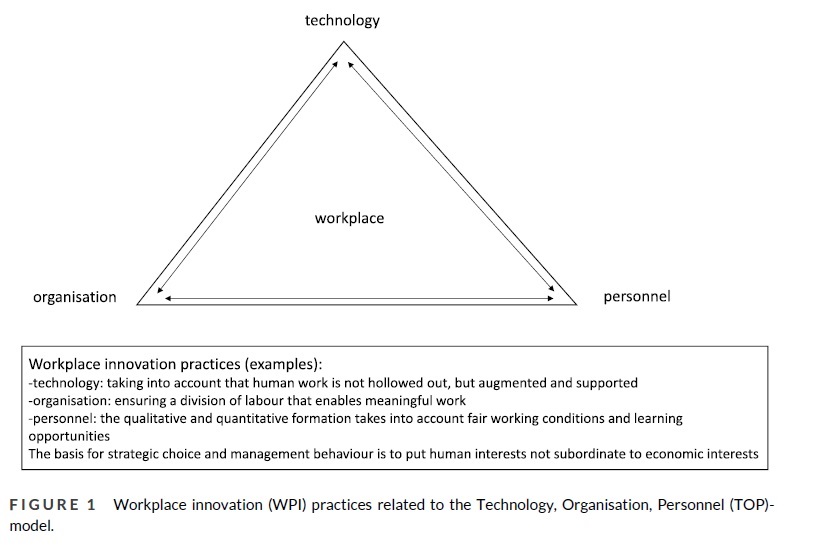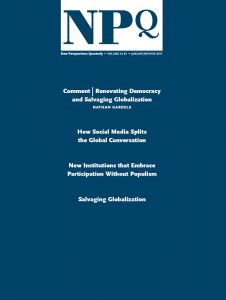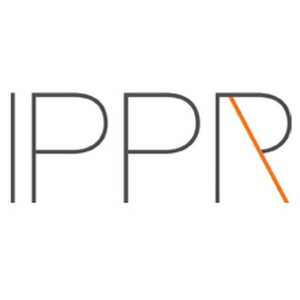Workplace innovation: a human-centric point of view

There is no consensus about the meaning of workplace innovation (WPI) (Oeij, 2024; Oeij & Dhondt, 2024). None is there agreement on whether WPI should be seen as a cause or an effect or a mediating variable. This leaves a void in understanding WPI both scientifically and practically. We regard workplace innovation as a practice to improve how an organisation performs while maintaining or creating a good quality of work for its employees. WPI has, therefore, a causal or mediating role. In other words, we see it as a means to an end, not as a goal in itself. WPI has, in our view, human centricity as a point of departure (Breque et al., 2021). Human-centric describes the process of making the preferences of people the most important priority in the design of jobs and organisations, management decision making and problem-solving strategies (like the implementation of new technology). Putting people central in general interests, comes with applying certain norms and values. Human-centric values include freedom, dignity and autonomy, privacy and data protection, non-discrimination and equality, diversity, fairness, social justice, and internationally recognised labour rights. WPI intends to balance, not trade-off, social values and economic values as joint optimisation. Joint optimisation recognises that there are dilemmas between certain social and economic goals, but differences can be overcome.
The ‘workplace’ is defined by Eurofound as both the immediate working environment and the organisation as a whole. This ranges from a single workstation where employees carry out their direct tasks to a multi-layered organisation of which employees are members through the employment relationship (Eurofound, 2015: 12). The workplace is the setting where work is carried out according to a form of division of labour as a kind of ‘work organisation’. WPI refers to innovation within the context of the workplace and work organisation. The term ‘innovation’ in WPI implies a renewal. Johannessen, Olsen and Lumpkin (2001) assert that the most fundamental of all the words used to define innovation is “newness,” and that it can be new for a company, the sector or the world. This implies that something that is not new to company A, can still be an innovation for company B.
Since there can be an endless number of innovations in workplaces we focus on the three major elements of the TOP-model, technology, organisation and personnel in Figure 1 (Oeij et al., 2006: 256; Dul et al., 1996).

The working definition of WPI is formulated as human-centric innovations with regard to TOP (Technology, Organisation, Personnel) in order to simultaneously enhance business performance and human performance. In general, business performance is the organisation’s ability to effectively and efficiently apply its resources and achieve its objectives. A major part of the effectiveness is to develop and implement innovations. For a commercial business, the main goal will be profitability and for a not-for-profit organisation, the goals will be more social than purely economic. Human performance represents, on the one hand, the human contribution to the organisation’s performance and refers to how people perform their work; on the other hand, how people learn from their work and develop themselves and how they cope with disturbances in the work process. The outcome of human-centric innovation with regard to people, should be meaningful work in which they are productive, work healthy and safely, and are challenged to learn and develop new skills and knowledge.
With regard to workplace innovations or workplace innovation practices, the optimisation of business performance and human performance, requires that decision-makers in organisations weigh the interests of stakeholders. Stakeholders are, for example, members of the organisation (employees, managers), beneficiaries (customers, clients, students, pupils, patients), shareholders (investors, owners) and ‘external agents’ (governmental, educational, financial, service institutes, etc.). Choices about WPI practices are associated with other choices, and these choices are interrelated as well. Such choices should balance the workplace elements of Figure 1: Technology, Organisation, and Personnel. For example:
- strategic choice, the management philosophy and business model: organisations that optimise business performance and human performance, may wish to be sustainable with regard to energy resources but also to human resources in achieving the organisation’s objectives. Human-centric choices imply a humanist or human-friendly approach, that allows participation and voice.
- technological choice: organisations that optimise business performance and human performance, apply technologies and digitalisation that improves productivity and at the same time augment, support and facilitate employees. Human-centric choices imply that technology does not hollow out the jobs of people, by far going division of labour, monitoring their output and steering and controlling their execution of tasks (for example by abusing algorithms).
- organisational choice: organisations that optimise business performance and human performance, avoid organisational structures with unnecessary interdependencies and an overload of coordination demands (bureaucratic organisations). Human-centric choices in organising imply decision latitude at the level where problems occur (autonomy), decentralisation wherever possible (responsibility) and transparency of [effects of] organisational policies to all those being affected (participation and voice).
- choices about personnel: organisations that optimise business performance and human performance, apply human resources practices that enhance the innovative capability of the organisation and the skills and competencies of employees; human-centric personnel choices can balance the (qualitative and quantitative formation) needs of employers with the needs of employees in the selection of working conditions, employment relations, remuneration schemes and type of contracts, educational programmes, and combining working life and private life. Demands of equality, diversity and inclusiveness are part and parcel of human-centric HR practices.
The human-centric approach of WPI, as we endorse it, stems from sociotechnical systems thinking, which seeks to optimise technical and social systems, and humanisation movements that intend to protect the rights of people for decent work. These movements strived for the ‘advancement of work’ within the capitalist system, as an instrument to enhance innovation. Many adherents were convinced that workers were not interested in money alone, but that workers wished work that was meaningful to them, physically not too demanding, enabling them to carry out leisure activities in their free time. In short: good work. People were not only extrinsically motivated but also intrinsically. This has led to a broad quality of work development to improve jobs from diverse social scientific angles. One of those developments was the modern sociotechnical systems design approach, whose hallmark was to combine the notion of good work with organisational designs that could excel in terms of quality, price and innovativeness. The approach, developed by De Sitter, connected the psychological Job Demands – Control model (Karasek, 1979; Karasek & Theorell, 1990) with the operational design criteria of sociotechnical thinking into an ‘integral organisation design approach’. This modern sociotechnical systems design approach is thus aimed at optimising business performance and human performance (De Sitter et al., 1997; Kuipers et al., 2020).
We see WPI through this lens of ‘good work’ and human-centricity. Whenever a strategic, technological, organisational, or personnel innovation or change is at hand, it should meet the requirement to simultaneously improve the business performance and human performance. With this perspective in the back of our minds, we analysed elsewhere the literature on WPI (Oeij, Dhondt & McMurray, 2021; Oeij & Dhondt, 2024; see also Oeij, 2024). The WPI lens can be used in different scientific disciplines. These disciplines can inform different kinds of benefits. The working definition of WPI in this contribution, formulated as “human centric innovations with regard to TOP (Technology, Organisation, Personnel) in order to simultaneously enhance business performance and human performance”, is in line with our earlier developed definition:
Workplace innovation is an integral set of participative mechanisms for interventions relating to structural aspects (e.g., organisational design) and cultural aspects (e.g., leadership, coordination and organisational behaviour) of the organisation and its people with the objective of simultaneously improving the conditions for performance and quality of working life (Oeij & Dhondt, 2017, p. 66; Parker & Boeing, 2023: 92).
The structural aspects in this definition correspond with the design of the production process, jobs and technology (T & O op TOP, see Figure 1), which overlaps with the production structure and control structure in modern sociotechnical systems design (Kuipers et al., 2020); and the cultural aspects are a consequence of these structural aspects, in the sense that they enable and disable particular organisational behaviours and leadership styles (Karanika-Murray & Oeij, 2017). This corresponds with strategic choices on labour supply and HR policies (the P in TOP). The definition includes participative mechanisms, pointing to the distinction between the content of WPI (what) and the process of designing and implementing WPI (how). Participation and engagement are not only a hallmark of WPI but also of a human-centric approach (Breque et al., 2021).
References
- Breque, M., De Nul, L., Petridis, A. (2021). Industry 5.0: towards a sustainable, human-centric and resilient European industry. Luxemburg: Publications Office of the European Union, https://data.europa.eu/doi/10.2777/308407
- De Sitter, L. U., Den Hertog, J. F., & Dankbaar, B. (1997). From complex organisations with simple jobs to simple organisations with complex jobs. Human Relations, 50(5), 497–534.
- Dul, J., Dhondt, S., & Vink, P. (1996). Making companies more successful by balancing technological, organizational and human factors. In O. Brown & H. W. Hendrick (eds), Organisational design and management – V (pp.547-551). Amsterdam: Elseviers Science.
- Eurofound (2015).Workplace Innovation in European companies. (Oeij, P., Žiauberytė-Jakštienė, R., Dhondt, S., Corral, A., Totterdill, P., Preenen, P.). Report for Eurofound.Luxemburg: Publications Office of the European Union.
- Johannessen, J.-A., Olsen B., and Lumpkin, G.T. (2001. Innovation as Newness: What Is New, How New, and New to Whom? European Journal of Innovation Management 4(1): 20–31.
- Karanika-Murray, M., & Oeij, P.R.A. (2017). The role of work and organisational psychology for workplace innovation practice: From short-sightedness to eagle view? European Work and Organisational Psychology in Practice. Special Issue on Workplace Innovation, 1, 19-30.
- Karasek, R (1979). Job demands, job decision latitude and mental strain: Implications for job redesign. Administrative Science Quarterly, 24, 285-308.
- Karasek, R A & Theorell, T G. T. (199O). Healthy Work: Stress, Productivity and the Reconstruction of Working Life. New York: Basic Books
- Kuipers, H., Van Amelsvoort, P., & Kramer, E.-H. (2020). New ways of organizing: Alternatives to bureaucracy. Leuven, Den Haag: Acco.
- Oeij, P. (2024). When is a review of workplace innovation useful for practice? – Sociology Lens Insights. Opinion / Sociology of Organizations & Work, 28th March 2024.
- Oeij, P. & Dhondt, S. (2017), Theoretical approaches supporting workplace innovation. In: P.R.A. Oeij, D. Rus, & F.D. Pot (eds), Workplace innovation: Theory, research and practice (pp. 63–78). Series ‘Aligning Perspectives on Health, Safety and Well-Being’. Cham (Switzerland): Springer.
- Oeij, P.R.A. & Dhondt (2024). Reviewing workplace innovation as a plea for a practical approach. Sociology Compass, e13203. https://doi.org/10.1111/soc4.13203.
- Oeij, P.R.A., Dhondt, S., & McMurray, A. (2021) Workplace innovation literature review: a converging or diverging research field? A preparatory study for a research agenda. TNO Report R12732. Leiden: TNO Healthy Living.
- Oeij, P.R.A., Wiezer, N.M., Elo, A.-L., Nielsen, K., Vega, S., Wetzstein, A., Zołnierczyk (2006). Combating psychosocial risks in work organisations: Practice of interventions in Europe. In S. McIntyre & J. Houdmont (eds) Occupational health psychology: European perspectives on research, education and practice. Vol. 1 (pp. 233-63). Castelo de Maia: Ismai Publishers.
- Parker, S.K., & Boeing, A.A. (2023). Workplace innovation in the digital era: a role for SMART work design. In: P.R.A. Oeij, S. Dhondt, A.J. McMurray (eds.), A Research Agenda for Workplace Innovation: The Challenge of Disruptive Transitions (pp. 91-112).Cheltenham, UK: Edward Elgar Publishing.




1099-1328/asset/dsa_logo.jpg?v=1&s=e4815e0ca3064f294ac2e8e6d95918f84e0888dd)